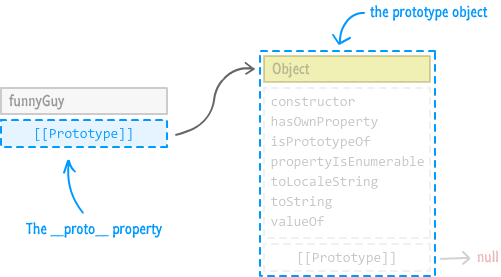You’re mostly right, except for “Point is the prototype of myPoint” and “The __proto__ property of myPoint is pointing to its prototype, which is Point.” These are not correct. Point is just the constructor of myPoint, and the prototype of myPoint is actually Point.prototype.
The biggest thing to be careful of here is naming. There are “prototypes” and there are prototype properties. These are not the same thing. The prototype of any object is what its __proto__ property points to - something referred to as “[[Prototype]]” in the spec. The prototype is what an object uses to access shared properties when access is made on a property that it doesn’t have defined on its own instance.
var shared = { num: 1 };
var instance = { str: "a" };
console.log(instance.str); // "a"
console.log(instance.num); // undefined
Object.setPrototypeOf(instance, shared);
console.log(instance.str); // "a"
console.log(instance.num); // 1 <- coming from its prototype
When you create a constructor function like Point, it is created with a prototype property. This is not the prototype of the Point function object. It actually has it’s own prototype which you can access through Point.__proto__, This awkwardly named prototype property actually refers to the object which gets set as the prototype (i.e. __proto__ value) for the instances created from Point when used as a constructor with the new keyword. The prototype property would be better named as prototypeForInstancesThisConstructorCreates.
function Point(x, y) {
this.x = x;
this.y = y;
}
var myPoint = new Point();
console.log(myPoint.__proto__ === Point.prototype); // true
Notice here that myPoint's prototype is being referenced by a __proto__ property (not a prototype property) and the value in the prototype property of Point is not Point's prototype. Seems a little backwards, doesn’t it?
Basically what happens is, when Point is used as a constructor, internal code in the JavaScript runtime performs this:
// pseduocode
if (is_called_with_new(current_function)) {
this = allocate_new_object_instance()
Object.setPrototypeOf(this, current_function.prototype)
set_default_return_value_of(current_function, this)
}
Object.setPrototypeOf is what sets up the __proto__ link. (Note: generally the use of __proto__ is discouraged in favor of Object.setPrototypeOf and Object.getPrototypeOf, though __proto__ is what you see when debugging objects so its good to know what it means.) So what you get from new Point is a new JavaScript object that is mostly like a new {} object, but has a prototype refering to the prototype property of the function that created it. That and the function gets run with this being a reference to that object which in the case of Point here, also assigns some x and y properties to the object.

